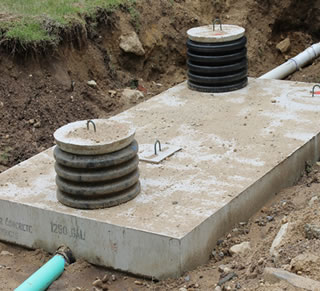Basic Septic Tank Systems are a viable alternative for waste water processing. Like any other device, septic tanks must be properly installed, maintained, and repaired. Literature verifies that the average life of a septic system is between 25 to 30 years, with proper maintenance.
Basic septic tanks systems consist of the tank, a distribution box or lines, and the drain field. Older tanks are one chambered, while newer ones have two chambers and filters. The waste water from the home enters the tank through the inlet pipe. The waste water is allowed to settle, with a desired retention time of at least two days. During this period the heavier material settles to a layer called sludge, while the lighter materials including oils and grease, form an upper layer called the scum layer. Anaerobic Bacteria (oxygen hating) work on the sludge breaking down the material so that most of it will eventually wind up in solution and be able to move out the outlet pipe into the distribution box or lines and then the drain field.
The tank has to be properly sized according to the occupant load and the computed resultant daily flow. The build-up of scum and sludge in the tank is dependent on the daily flow and the composition of the waste. The proper sizing will allow the required retention time for the biological processing.
The drain field is designed to gradually percolate the waste water through the properly placed soil type that allows mineral and bacterial processing prior to the effluent reaching the ground water table. The drain field is sized to match the estimated daily flow from the tank.
The septic tank normally remains filled to its liquid top level with an air space of 8-10 inches in order to function properly. Periodic pumping (every 3-5 years) is required to remove the sludge and solids from your septic tank. If the tank is not pumped out periodically, the solids are carried into the drainfield; rapid clogging occurs; premature failure follows; and finally, the drainfield must be replaced. Pumping your septic tank is less expensive than replacing your drainfield.
Your septic tank may also have a filter. This filter requires periodic cleaning every six to twelve months depending on usage. If the filter becomes clogged it will obstruct the flow from the tank to the drainfield and cause backups.

